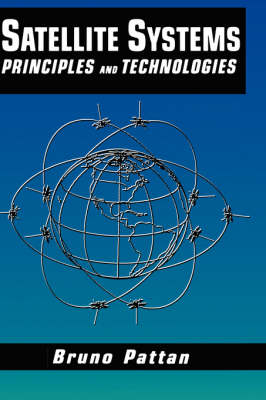
Satellite Systems
Principles and technologies
Seiten
1993
|
1993 ed.
Van Nostrand Reinhold Inc.,U.S. (Verlag)
978-0-442-01357-8 (ISBN)
Van Nostrand Reinhold Inc.,U.S. (Verlag)
978-0-442-01357-8 (ISBN)
Covers the satellite principles and their associated technologies while focussing upon the methodology of launching satellites, keeping them there, the environments under which they operate, and other facets particular to their operation. This book is useful for engineers, technicians, communication lawyers, weather professionals, and students.
This reader-friendly resource covers the broad spectrum of satellite principles and their associated technologies. While other books limit their coverage to specialized services or to satellite payloads such as communication satellites, Satellite Systems focuses upon the methodology of launching satellites, keeping them there, the environments under which they operate, and other facets particular to their operation. Pattan's detailed, elaborate approach does not assume that the reader is versed in esoteric mathematics. Satellite Systems is specific enough to be a valuable working-tool to scientists and engineers in related fields, yet general enough to be accessible to students and interested lay people. Pattan throughly explores the concepts and technologies of satellite systems in simple, direct terms. Satellite Systems includes precise coverage of: *various orbits and the services they provide *international launch of vehicles and launch sites *phased array antennas for satellite network applications *mobile satellite services from land vehicles, aircraft, and ships *low orbit satellites for telecommunication and position determination applications *international frequency allocations for satellite control, payload management, and status *geometric relationships between satellite and Earth stations used in interference analysis, orbit determination, and location *the hostile environments in which satellites operate and cope *and much more Satellite Systems is a self-contained, extensive introduction that offers professionals and advanced undergraduate and graduate students of satellite systems the tools they need for in-depth understanding of the complexities of the subject. It is ideal as both a reference and a training text for engineers, technicians, communication lawyers, weather professionals, telecommunications experts, students, and anyone interested insatellites and satellite technology.
This reader-friendly resource covers the broad spectrum of satellite principles and their associated technologies. While other books limit their coverage to specialized services or to satellite payloads such as communication satellites, Satellite Systems focuses upon the methodology of launching satellites, keeping them there, the environments under which they operate, and other facets particular to their operation. Pattan's detailed, elaborate approach does not assume that the reader is versed in esoteric mathematics. Satellite Systems is specific enough to be a valuable working-tool to scientists and engineers in related fields, yet general enough to be accessible to students and interested lay people. Pattan throughly explores the concepts and technologies of satellite systems in simple, direct terms. Satellite Systems includes precise coverage of: *various orbits and the services they provide *international launch of vehicles and launch sites *phased array antennas for satellite network applications *mobile satellite services from land vehicles, aircraft, and ships *low orbit satellites for telecommunication and position determination applications *international frequency allocations for satellite control, payload management, and status *geometric relationships between satellite and Earth stations used in interference analysis, orbit determination, and location *the hostile environments in which satellites operate and cope *and much more Satellite Systems is a self-contained, extensive introduction that offers professionals and advanced undergraduate and graduate students of satellite systems the tools they need for in-depth understanding of the complexities of the subject. It is ideal as both a reference and a training text for engineers, technicians, communication lawyers, weather professionals, telecommunications experts, students, and anyone interested insatellites and satellite technology.
Preface. In the beginning. Satellite orbits and dynamics. Special orbits. Satellite launch mechanics. International launch facilities. International launch vehicles. In-orbit propulsion systems. Rocket thrust/ equation. Satellite stabilization- attitude control. Spacecraft power generation and storage. Spacecraft thermal management. Telemetry, tracking, and command subsystem. Satellite frequency allocation and management. Satellite payloads. Earth stations technology. Satellite networks communication links. Earth station- satellite geometrics. Satellite networks electromagnetic and physical interference. Appendix A: glossary of abbreviations. Appendix B: glossary of terms and expressions. Index
| Erscheint lt. Verlag | 31.3.1993 |
|---|---|
| Zusatzinfo | X, 406 p. |
| Verlagsort | New York |
| Sprache | englisch |
| Maße | 155 x 235 mm |
| Themenwelt | Mathematik / Informatik ► Informatik |
| Naturwissenschaften ► Physik / Astronomie ► Mechanik | |
| Technik ► Elektrotechnik / Energietechnik | |
| Technik ► Nachrichtentechnik | |
| ISBN-10 | 0-442-01357-4 / 0442013574 |
| ISBN-13 | 978-0-442-01357-8 / 9780442013578 |
| Zustand | Neuware |
| Haben Sie eine Frage zum Produkt? |
Mehr entdecken
aus dem Bereich
aus dem Bereich
Statik - Kinematik - Kinetik - Schwingungen - Festigkeitslehre
Buch | Hardcover (2021)
Hanser, Carl (Verlag)
29,99 €


